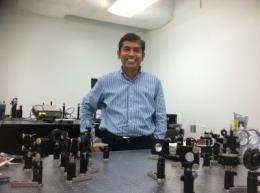A new use for atomically engineered gold

A University of Central Florida assistant professor has developed a new material using nanotechnology, which could help keep pilots and sensitive equipment safe from destructive lasers.
UCF Assistant Professor Jayan Thomas, in collaboration with Carnegie Mellon University Associate Professor Rongchao Jin chronicle their work in the July issue of the journal Nano Letters.
Thomas is working with gold nanoparticles and studying their properties when they are shrunk into a small size regime called nanoclusters. Nanoparticles are already microscopic in size, and a nanometer is about 1/80000 of the thickness of a single strand of human hair. Nanoclusters are on the small end and nanocrystals are on the larger end of the nanoregime. Nano clusters are so small that the laws of physics that govern the world people touch and smell aren't often observed.
"Nanoclusters occupy the intriguing quantum size regime between atoms and nanocrystals, and the synthesis of ultra-small, atomically precise metal nanoclusters is a challenging task," Thomas said.
Thomas and his team found that nanoclusters developed by adding atoms in a sequential manner could provide interesting optical properties. It turns out that the gold nanoclusters exhibit qualities that may make them suitable for creating surfaces that would diffuse laser beams of high energy. They appear to be much more effective than its big sister, gold nanocrystal which is the (nano) material used by artists to make medieval church window paintings.
So why does it matter?
Think of commercial pilots or fighter pilots. They use sunglasses or helmet shields to protect their eyes from the sun's light. If the glasses or helmet shield could be coated with nanoclusters tested in Thomas' lab at UCF, the shield could potentially diffuse high-energy beams of light, such as laser. Highly sensitive instruments needed for navigation and other applications could also be protected in case of an enemy attack using high energy laser beams.
"These results give me great pleasure since the technique we used to study the optical properties of these atomically precise particle is one invented by UCF Professors Eric VanStryland and David Hagan many years ago," Thomas said. "But the progression we've made is very exciting."
Because nanoclusters appear to have a better ability to diffuse high beams of energy, they are a promising area for future development. There is still plenty of applications to be explored using these very interesting atomically engineered materials. Until now, much research has been focused on the larger nanocrystal.
Thomas is also exploring the use of these particles in the polymer material used for 3D telepresence to make it more sensitive to light. If successful, it can take the current polymers a step closer to developing real time 3D telepresence.
3D-Telepresence provides a holographic illusion to a viewer who is present in another location by giving that person a 360-degree view (in 3D) of everything that's going on. It's a step beyond 3-D and is expected to revolutionize the way people see television and in how they participate in activities around the world. For example, by allowing a viewer to "walk around" a remote location as if in a virtual game, a surgeon could help execute a complicated medical procedure from thousands of miles away.
More information: http://dx.doi.org/10.1021/nl301988v
Journal information: Nano Letters
Provided by University of Central Florida

















